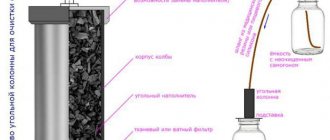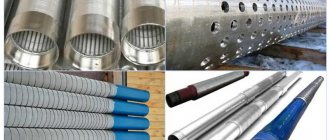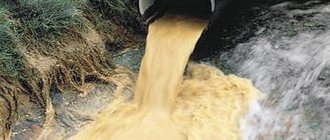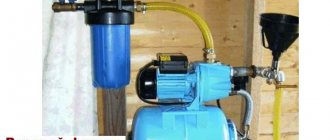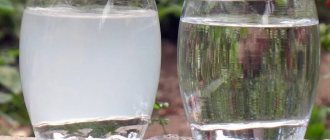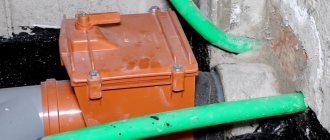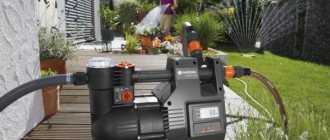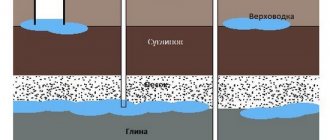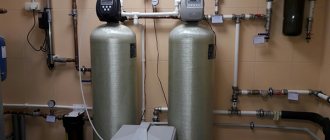Here you will learn:
- Well water quality
- Why do you need to purify water from a well?
- Types of contaminants and choice of filters
- Types of coarse filters for wells
- What well filter is required for your suburban area?
- Making filters for a well with your own hands
- Integrated purification and water treatment schemes
A well filter is a mandatory device, without which it is impossible to operate a water supply system. First of all, a coarse filter is installed in the well itself, and then fine filters. Such complexes are supplemented with an aeration system, ozonation or ultraviolet devices.
Is cleaning necessary?
A number of indirect signs indicate that well water needs to be purified. You may encounter:
- Sludge, indicating the accumulation of undesirable substances in the water, the appearance of which is caused by the processes of decay.
- A characteristic metallic taste that worsens the taste characteristics of the produced water. After installing the filter, the organoleptic properties of the liquid are significantly improved.
- Plumbing fixtures and dishes have a yellowish tint. Its appearance is facilitated by dissolved salts and a number of other substances deposited on the surface.
- Cloudy sediment with some silt due to the presence of harmful bacteria.
- Characteristic smell of “rotten eggs”.
Water should not have an unpleasant odor or impurities Source build-experts.ru
Against rust and sand: main filter
- What's good: easy to install
- What’s bad: filters mainly mechanical particles
The principle is the same as in the wash filter, only instead of a mesh there is a filter element made of polypropylene. It traps smaller particles: from 10 to 20 microns in size. It can get wet, for example, if your water of good composition comes through rusty pipes or along with sand. The element itself is very inexpensive (up to 100 rubles), it usually lasts a family of three people at the dacha for a month.
To make it easier to control the degree of contamination, choose a model with a transparent bulb. True, it has a specific drawback: the flask allows sunlight to pass through, and the water can quickly “bloom,” especially in the sun. So it doesn’t hurt to cover it with a dark, removable cover.
Cleaning steps
A well water purification system for a private home includes several stages:
- Pre-cleaning. Allows you to get rid of coarse impurities: sand, clay residues, various mechanical particles. For this purpose, coarse filters or settling tanks are used. This stage is mandatory for any cleaning system, as it can significantly increase the service life of the installed equipment.
- Removal of dissolved chemical impurities and gases . Allows you to get rid of excess amounts of magnesium, iron and other components. The cleaning method and type of filter used are selected taking into account the composition and amount of chemical impurities.
- Softening . Using the ion exchange method, salts are removed from water. They precipitate and are then removed from the water in a subsequent purification step.
- Fine cleaning . A filter with a specific configuration helps to filter out the smallest particles. Their size is 5 microns.
- Disinfection . At the biological treatment stage, it is possible to get rid of unwanted bacteria and microorganisms.
- Drinking preparation . Reverse osmosis systems are mainly used. Relevant exclusively for the preparation of water intended for the preparation of water or drinking.
The degree of purification may vary depending on the filter device Source vodopodgotovka-vodi.ru
Water purification from a well for a private home may include various stages.
A chemical analysis of the extracted liquid will help determine the number of stages. The result obtained will allow you to accurately understand which substances have exceeded their concentrations and in what quantities.
When is filtration necessary?
Water from any well needs to be cleaned with a filter.
Even if all chemical indicators are normal, routine mechanical cleaning is necessary. A coarse filter successfully copes with this, the task of which is:
- prevent various mechanical impurities from entering the water,
- protect well equipment from premature wear.
If well water is used to supply water to the entire house, small particles of rock can cause breakage of water supply shut-off elements and lead to breakdown of the entire system.
Installing a mechanical well filter is the first stage of cleaning .
The types of subsequent filters will depend on the result of a chemical analysis, which will indicate which elements need to be filtered.
If the water has increased hardness, high levels of iron or hydrogen sulfide, it is necessary to install additional filtration systems .
They will help:
- Remove harmful components;
- Organic compounds;
- Soften the water;
- Improve its taste;
- Make it safe to drink.
Main types of filtration equipment for pre-treatment
The design and operating principle of filters may differ significantly. Used to remove mechanical impurities with different fractional compositions. Some allow you to get rid of particles with a size of 20 - 100 mm, while others effectively cope with inclusions of 0.25 - 0.5 mm. The area of use and the achieved effect largely depend on the type of soil in a particular area.
Gravel
A simple and economical option. Allows you to get rid of large particles. Increases the life of the well. A gravel filter for water from a well has certain requirements for the installation procedure:
- The transverse dimensions of the pipe are smaller than the diameter of the well.
- The fractional composition of the gravel backfill should be on average 5 times greater than the size of small rock particles.
- The height of the sprinkling depends on the gravel layer. Usually 0.9 - 2 m. The more salts dissolved in the water, the higher the gravel layer is poured.
There are a number of requirements for the filter used. Source piccy.info
If the aquifer contains predominantly sand, the gravel system will not cope well with the task. It is advisable to use a mesh or wire type filter for a sand well.
The advantages of such equipment include:
- Simplicity of design.
- Prevent possible rock collapse.
- Reduce the likelihood of equipment corrosion.
- Safety of use. When using it, you don’t have to worry about the taste of the water.
See also: Companies specializing in utilities: water supply, heating and sewerage.
Reticulate
Filters for water wells of this type are made with cells of different shapes and sizes. This allows you to retain small particles of various rocks. They are widely used to purify water produced in areas with a clay-sand layer.
According to the configuration of the cells of the product, there are:
- Square.
- Keeper or multilayer.
- Galunny.
The size and type of cells are selected individually. The size and configuration of mechanical impurities contained in a test batch of water extracted from a well are taken into account. The area of square cells varies in the range of 0.12 – 3 mm2.
Various materials are used to make the strainer. Stainless steel products have proven themselves well. They are not afraid of prolonged exposure to water. If you follow the manufacturer's recommendations, their service life reaches 30 - 50 years.
The size and shape of the cells affects the functionality Source www.kai.by
The size of galloon and keeper mesh includes two numbers: the number of horizontal and vertical wires per unit area. Thus, the dimension 6/40 means that each square contains six vertical wires and 40 horizontal ones.
Mesh models are easy to install. Allows cleaning. Repairable. However, they can cause a decrease in water pressure due to the high resistance of the materials used. Not suitable for water with a high iron content: the resulting sediment clogs the cells, the product begins to wear out intensively and you have to look for a new one.
Slotted
Such filters for water purification in a private house from a well are suitable for a water supply system mounted on unstable soil prone to collapse:
- Sandy.
- Galechny.
- Shchebnev.
A thoughtful design allows you to retain particles of different fractional compositions inside the filter. Can be mounted on systems with low pressure. The basis of slotted models is a pipe with a characteristic perforation. The sufficient strength of the material used and the presence of a special stiffening belt allows the product to withstand high pressure. However, during operation there is a risk of clogging the cracks.
The slits are located at equal distances Source mozfiles.com
The number and size of slots are selected individually, taking into account water hardness. The higher this indicator, the larger the slots to be formed should be. To increase the versatility of the device, a combined hole shape is chosen.
How to take into account the terrain?
The choice of filter type depends on the type of aquifer in the area where the well is planned to be drilled.
- for rocky and semi-rocky rocks it is worth choosing slotted and mesh products,
- keeper nets are installed in coarse-grained and gravelly sandy soils,
- For medium and fine-grained sand, galloon mesh filters are used.
Water in a particular area has a certain set of quality characteristics that can be easily determined using chemical analysis .
Important. If the permissible dose, for example iron, is exceeded, the mandatory installation of an additional carbon filter or other treatment facilities is required.
Main types of iron removers
Filters for water from a well to a private home allow you to get rid of not only iron, but also various chemical impurities: fluorides, nitrates, nitrites, lead, radium and arsenic. The presence of such substances is unacceptable. An increased concentration of iron can harm human health. To reduce its concentration the following are used:
- Non-pressure installations.
Water coming from the well flows through nozzles into a large reservoir. Its capacity starts from 600 liters.
The water level is controlled using special sensors that determine the upper and lower levels. To prevent the tank from overflowing, a special pipe is provided through which, if necessary, excess water is discharged. As soon as the container is completely filled, the compressor turns on and air begins to flow inside and is distributed using a divider.
In the process of spraying water, dissolved iron combines with oxygen, forming a trivalent compound. Mesh models are used to remove the resulting sediment.
Gravity water treatment system Source wixstatic.com
Well water quality
Compared to a well, a well is a safer, from a sanitary point of view, drinking source, since it is closed and the likelihood of introducing external contaminants into it is significantly lower.
The chemical and microbiological parameters of water depend on the type of well.
- The Abyssinian well has a depth of about 8-12 m. Usually the water in it is slightly mineralized and quite clean. But the microbiological composition does not always meet the standards. It may contain representatives of the nitrogen group (nitrites, nitrates, ammonia), pesticides and other contaminants from the soil.
- A well in sand has greater depth than the Abyssinian. It is less susceptible to surface contamination and is usually less mineralized than artesian. But in some cases, this source may also contain dangerous microorganisms, iron, calcium, organic matter, and a nitrogen group.
- The artesian well is the deepest. Usually it is ideal in its microbiology, but is often mineralized. Artesian water contains hardness salts (primarily calcium), hydrogen sulfide, as well as inorganic iron and manganese. Since the latter are in an unoxidized form, the water appears transparent, but becomes colored and acquires sediment only after settling. In addition, a brown or black coating forms on sanitary appliances and kettles.
Whatever the well, before using it it is necessary to take the water for analysis to a specialized laboratory.
In this case, it is mandatory for any source to determine the following indicators:
- chromaticity;
- turbidity;
- general iron;
- general rigidity;
- chlorides;
- nitrites, nitrates, ammonia;
- oxidability;
- alkalinity;
- pH;
- presence and concentration of microorganisms.
This data will help not only to identify problematic indicators in the water, but also to choose the right purification system. It is possible that other data may be needed, for example, the content of manganese, which often accompanies iron.
If the water meets the standards in all respects, then you can do without water treatment. An exception can be made when softening is required for water used for heating devices. After all, even with medium hardness, scale formation occurs.
Reverse osmosis plants
The devices help to completely disinfect water. They allow you to get rid of unwanted bacteria and achieve high-quality cleaning. A multi-stage well water purification system allows you to get rid of various types of impurities. The operation of such equipment is based on the principle of liquid passing through a membrane under high pressure. A special pump is used to supply water.
The design of the membrane is such that only water molecules pass through it. The impurity remains outside. After cleaning, the accumulated dirt is simply washed off the surface of the membrane and sent down the drain. The presence of a self-cleaning function significantly increases the efficiency and service life of such equipment.
Having passed through the membrane, the water enters the flasks with a carbon backfill or a mineralizing layer. This is necessary to enrich it with microelements necessary for humans, since after passing through the membrane, the water’s parameters are close to distilled.
Sorptive
In the first option, carbon compounds, ion exchange resins and silver are used ; each element solves its own problem and has its own removable cartridge, which requires periodic replacement.
The frequency of cartridge replacement depends on the quality of the water.
Attention. Before installing a filter for chemical cleaning, a preliminary analysis of the water sample is carried out for the presence of various impurities.
Based on the analysis results, it is easy to determine the feasibility of installing various filter elements.
Chemical analysis allows you to determine what degree of purification is needed for water: deep or partial, aimed at removing specific chemical elements and impurities.
Video description
Reverse osmosis fights not only impurities, but also odors, as evidenced by the following video:
Systems are usually installed directly under the sink. A separate tap is used to supply drinking water. Replacement of the membrane and backfill must be carried out at specified intervals.
Purified water is close to distilled Source thewalls.ru
The simplest: wash filter
- What's good: works without cartridges
- What's bad: filters only mechanical particles
This is, indeed, the most basic filter, which is capable of filtering only mechanical particles ranging in size from 20 to 100 microns. Roughly speaking, this is a small glass in which a mesh is installed. The beauty of such a filter is that there is no need to change any cartridges - just open the drain tap, and the device will “self-clean” under the pressure of water.
This type should definitely be installed on the inlet highway. It will make the work of the other filters easier (they will not clog quickly) and will provide more or less clean water for faucets, washing machines, and showers.
One of the most reliable (but also expensive) wash filters is Honeywell.
- TV and audio
Top 9 TVs for a summer residence under 15,000 rubles
Disinfection
An important step to ensure that water meets regulatory requirements. To remove bacteria and unwanted microorganisms, the following are used:
- Blocks filled with sorbents of various types . Products containing coal have become widespread in everyday life. Thanks to its use, the filter improves the organoleptic properties of water.
- Ultraviolet . The device consists of a steel case with a quartz case and an ultraviolet lamp located inside. Passing through the device, water is irradiated by an ultraviolet stream and is thereby disinfected. The radiation dose depends on the level of contamination of water by microbiological organisms. The device allows vertical and horizontal placement.
- Chlorination, fluoridation . The method can be called traditional. The resulting suspension is subsequently removed. It is practically not used in private home water supply systems.
What height should I choose?
The height of the filter directly depends on the throughput of the soil and the diameter of the production pipe . The lower the throughput of the aquifer, the higher the filter should be.
To accurately calculate the height of the filter, an analysis of the components of the aquifer is required, which will be quite expensive when drilling an individual well.
The following indicators are used as a basis:
- The height of the filter must be at least 1 meter;
- Sandy soil has poor throughput, so the height of the filter should be at least 2 meters with a pipe diameter of 10-15 cm;
- Fine sandy soil will require a pipe height of about 4 meters, a dusty structure will require a height of 5-6 meters.
Briefly about the main thing
The filter is an important element in the water supply system of a private home, using a well as a source. With the correct selection of the model, it allows the produced water to comply with regulatory requirements. This makes it possible to use it not only for technical needs, but also for drinking.
Before you begin selecting filtration equipment, you should do a chemical analysis of the water. It will allow you to understand what impurities need to be gotten rid of and in what quantities.
To achieve the best effect, you should take care of multi-stage cleaning. Consistently passing through filters of different types, water can get rid of mechanical impurities, harmful substances and bacteria. Subsequent enrichment with useful elements will ensure compliance with regulatory requirements.
Ratings 0
Features for a country house or cottage
The choice of filter depends on the purpose for which the water will be used.
In the apartment, water is used for drinking and cooking.
This circumstance requires a more advanced cleaning system: sorption or reverse osmosis filters.
They are quite expensive, but have a number of advantages :
- Excellent water purification;
- Have great productivity;
- Long service life.
At the dacha and in a country house, most of the water is used for household needs, so installing expensive purification systems is not always advisable.
When choosing a well filter, it is important to determine the daily water requirement , which depends on the number of residents and purposes of use.
Reference. Borehole filters with lower capacity will cost less.
Silicon
Silicon water is useful only if it is contained in acceptable quantities (10 mg/l). If there is a lot of the element, it is dangerous to health; it forms brown silicate scale on the pipes. Water purification from flint is carried out using standard devices, but with special fillers. Precipitation with lime, sorption by aluminum and iron oxides, electrocoagulation, and magnesium sorbents are used. These are old methods, but better ones are: ion exchange, ultra and nanofiltration, electrodeionization, osmosis.
Well care rules
Firstly, it is recommended to fill the bottom of the shaft with non-erosable natural material (pebbles, quartz sand). Such an embankment acts as a mechanical filter - it traps debris, silt, and some impurities. It is important that the material does not float, is environmentally friendly, does not enter into chemical reactions and does not support rotting processes. For greater efficiency, it is better to perform layer-by-layer filling with fractions of different sizes.
Secondly, it is necessary to periodically clean the well mechanically - to do this, you need to pump out water from it or use a drainage pump. When cleaning, objects that have fallen into the shaft (debris, leaves) are removed and silt deposits are removed from the walls with scrapers. It is recommended to clean a regularly used well every 5-7 years. Mechanical cleaning is also necessary after a long period of inactivity of the well. This way, the drinking water filtration system will become clogged less frequently and will last longer.
Periodically, it may be necessary to disinfect the well. It is carried out if household waste or agricultural chemicals enter the tank; an animal or bird falls into it and dies; or after flooding by spring floods. In this case, you need to completely pump out the water, replace the bottom filter and perform mechanical cleaning of the internal walls of the shaft. They also check and restore the well’s tightness: seal cracks, chips, and leaks between concrete rings.
For modest needs: pitcher filter
- What's good: does not require installation
- What's bad: low performance
If your water is not of terrible quality and you need a small volume for cooking and drinking, you can try using a simple jug-type filter . Such models can have both simple activated carbon cartridges and complex ones for complete cleaning. The capacity is small, so for a large family it is better to choose an option with a larger volume: so that there is always water.
For example, this jug from Aquaphor holds 4.2 liters:
For dacha conditions, it is usually important to remove iron (it is what gives the water a “rusty” tint. Pay attention to filters with several stages of purification, including softening and especially iron removal. For example, this Geyser with a 4-liter jug:

